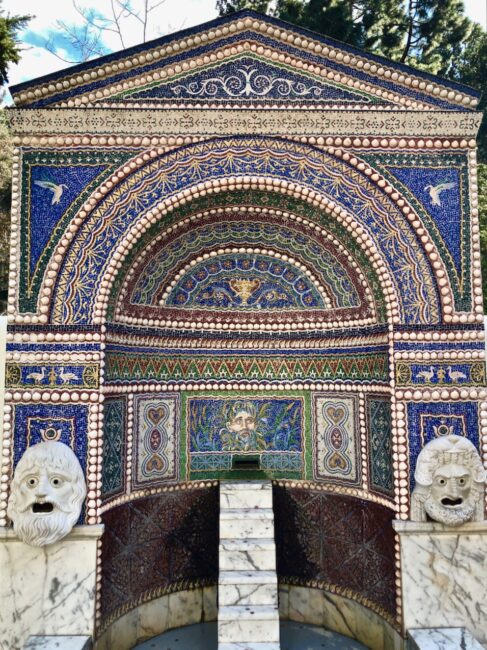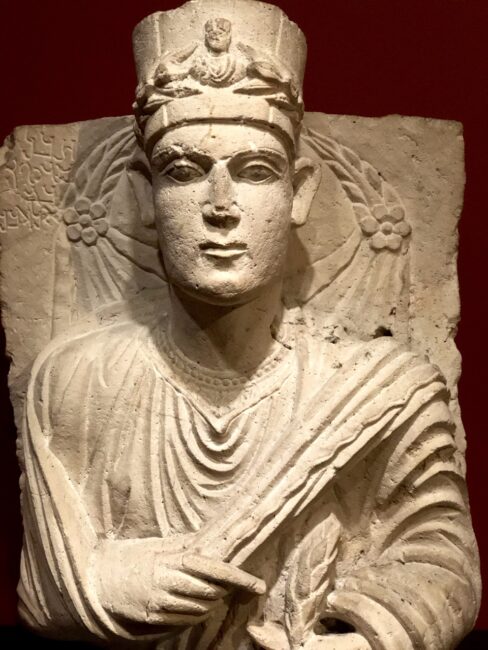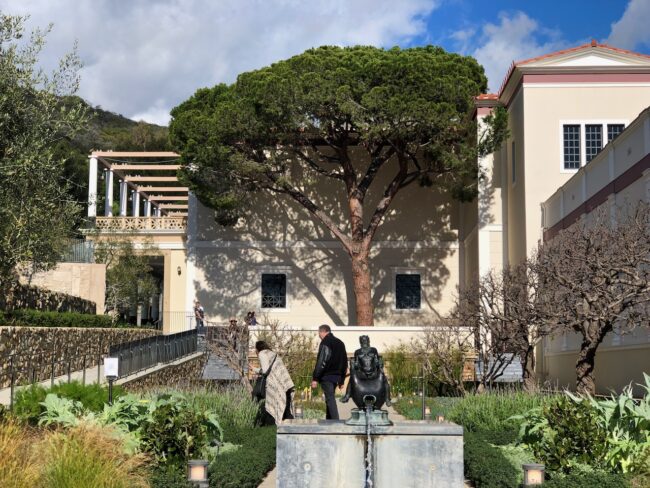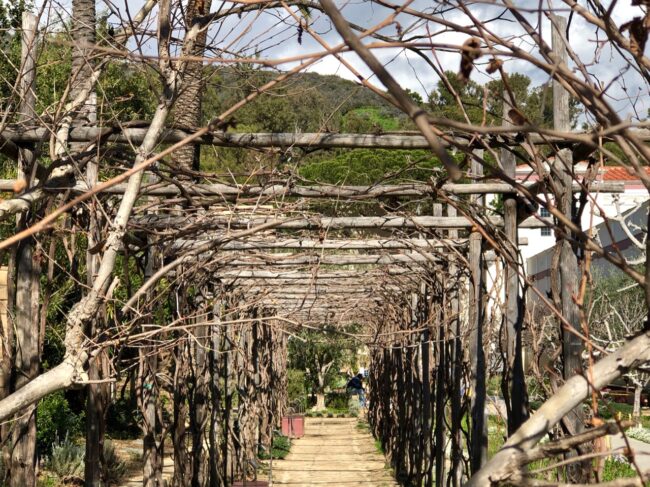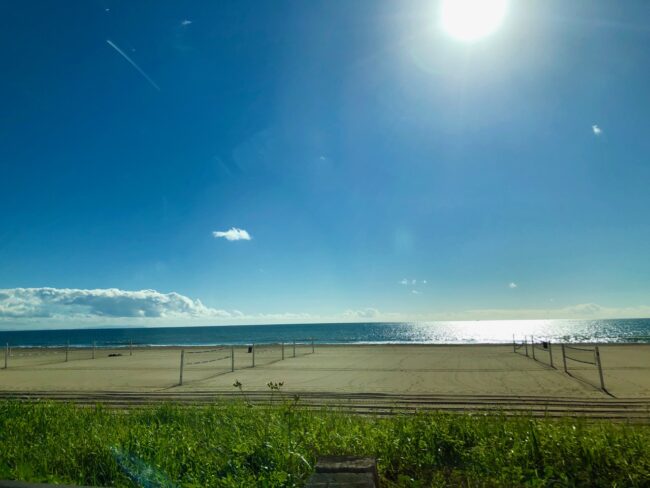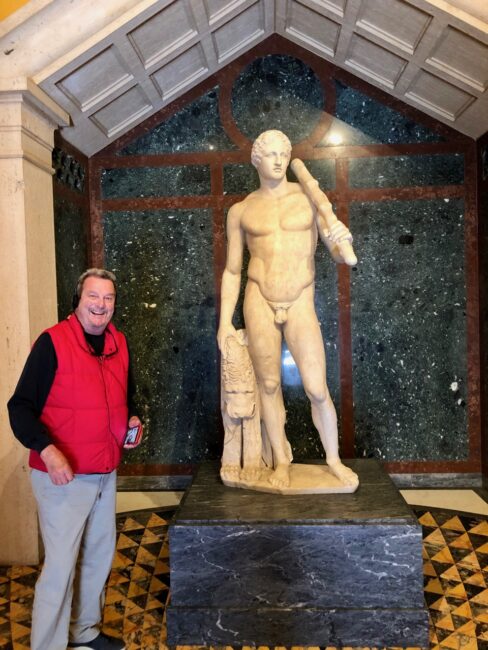
Mount Wilson Observatory – Mount Wilson
October 27, 2018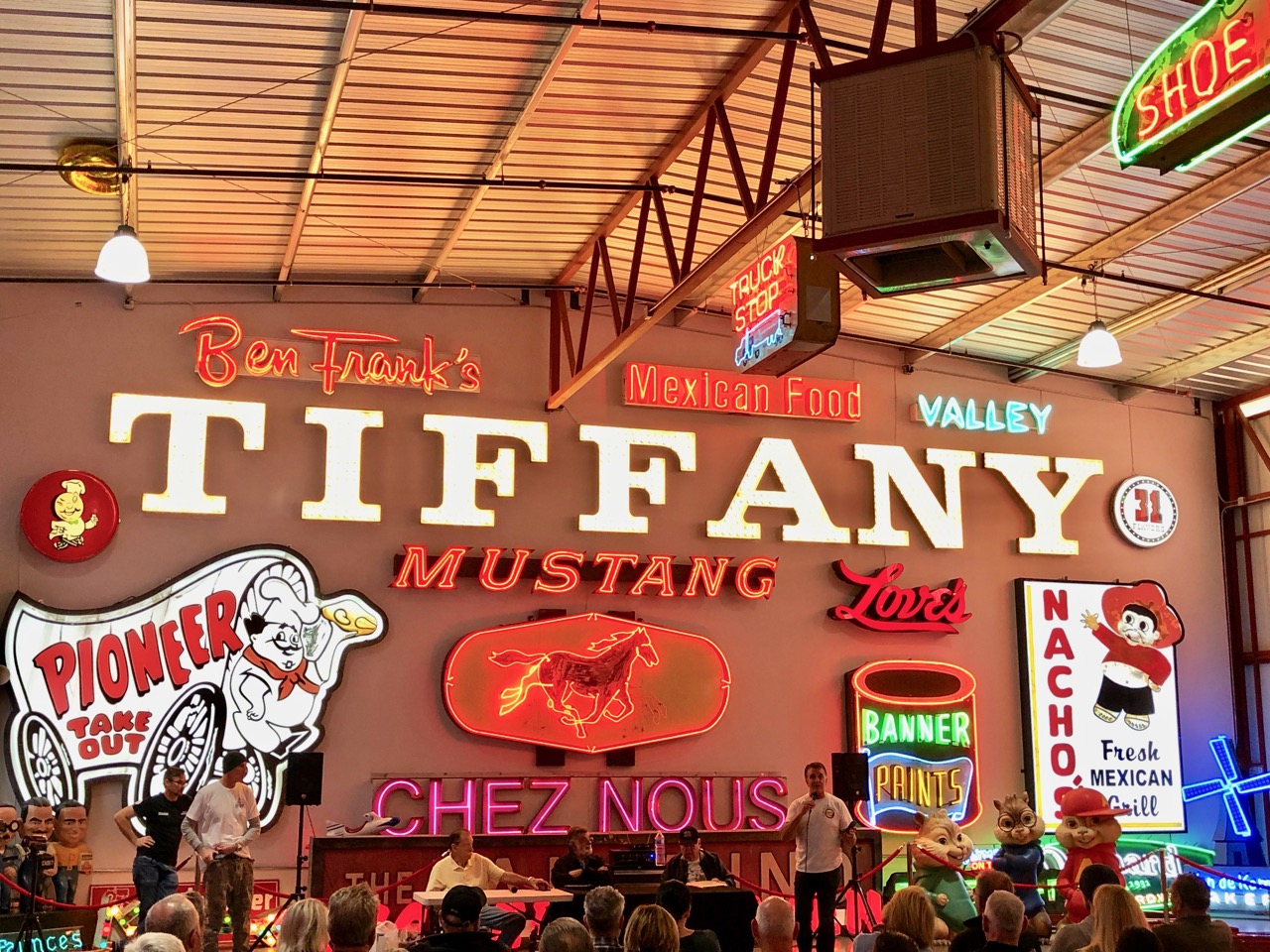
Valley Relics Museum – Van Nuys
April 3, 2019Antiquities With An Ocean View
The Getty Villa – Pacific Palisades
Last Visit: February 2019
Situated atop a hill in Pacific Palisades with commanding views of the Pacific Ocean lies a seaside villa housing one of the greatest collections of antiquities in the United States. Tracy and I had visited The Getty Villa back in 2010, but since then it has been remodeled, complete with a reinstallation project that, according to its director, “aims to more fully capture the history of ancient art.”
J. Paul Getty was the founder of Getty Oil Company, who also happened to become enamored in art and antiquity collecting. It was in 1938, while living in Rome, that he began his quest of collecting classical antiquities (some going back to 6,500 BC), not to mention Old Master paintings and European decorative arts (you can check those out now at the relatively nearby Getty Center off the 405 … photo below).
At one point in his life, Fortune magazine named him the “richest living American.” That’s Getty below on a trip to Jordan. (Photo courtesy of Getty Villa.)
In 1954, the J. Paul Getty Museum opened in his ranch house in Malibu. Getty had previously bought a ranch just after the end of World War II. It was intended to be a weekend retreat where his fifth wife Theodora could ride horses and he could display his growing art collection. He had a growing wife collection, as well, I guess.
Fast forward to the late 1960s, when Getty decided he wanted to construct a Roman-style villa on that 64-acre site in Malibu (now Pacific Palisades). Ground was broken in 1970 for the J. Paul Getty Museum, which would be modeled after Villa Dei Papiri, buried in 79 A.D. by the eruption of Mount Vesuvius. The villa was “the largest and most luxuriously furnished seaside villa that had been found during the early excavations at Herculaneum in Italy in the 1700s.” It’s rumored to have been owned by the rich father-in-law of Julius Caesar. Et tu, J. Paul?
In a Los Angeles Times 1974 interview, Getty stated, “Go to Pompeii and Herculaneum and see Roman villas the way they are now … then go to Malibu and see the way they were in ancient times.”
Although the museum was completed in 1974, and the 82-year-old Getty didn’t die until two years later (in England), he never saw the completed villa while alive. In death, however, he became part of the landscape. Getty is buried here on a private plot that overlooks the ocean. His eldest and youngest sons, George and Timothy, are buried there, as well (gravesite not open to the public).
Since the new installation a few years ago, the rooms have been arranged chronologically. Visitors start their audio tour in galleries devoted to the Neolithic and Bronze Ages of Greek art, then move on to Archaic, Classical, and Hellenistic periods, ending with ancient Roman sculptures. On the day we visited, we also toured a special exhibit called “UNDERWORLD … Imagining The Afterlife,” something I sadly ponder often.
For some reason, we never seem to take the correct route at museums, but eventually we see most everything. My dad used to say, “There’s the right way. There’s the wrong way. And … there’s Tom’s way.”
Cousins Susie and Bill from Seattle joined us on a Sunday that luckily fell in between two massive rain storms, offering some cool cloud formations throughout the day. To enter the Getty Villa, get your timed tickets in advance online (no showing up without tickets). The tickets are free, but you do pay $15 for parking. (This will also allow you to park at the Getty Center if you want to visit both sites on the same day.) We had an 11 a.m. entry time (the earlier the better, because by the time we left around 2 p.m. a stream of cars were idling in a long line waiting to reach the parking area).
From the parking lot, we walked by a grassy area with a view of the museum restaurant off to the right. Although we didn’t eat here on this trip, it looked good.
I should have heeded the sign as I nearly slipped, however this statue told me we were near the mane attractions. More about lions and Getty later.
Outside the main entrance lies an amphitheater modeled after ancient Roman and Greek theaters, where plays are performed occasionally.
We entered and picked up our free audioguides. Throughout the Getty there are corresponding numbers on many of the antiquities, and I found the guides to be interesting, albeit some of the descriptions were a little long to listen to the entire description. The Getty Villa literature says it “offers a taste of life in the first century AD.” Fortunately for guests, it has 21st century bathrooms.
We were standing in the Atrium, which was the main public room in a Roman house about 2,000 years ago. The open ceiling “let in light and air and allowed rainwater to fall into the sunken impluvium, where it was channeled to an underground cistern.”
The Inner Peristyle features decorative marble floors, walls and ceilings. The coffered ceiling “imitates decorative stonework on funerary monuments from the Street of Tombs in Pompeii.”
Just like the Villa Dei Papiri, it opens to the Inner Peristyle garden. In the Peristyle garden, reproductions of some of Villa Dei Papiri’s ancient bronze sculptures are situated around a small pool.
It was time to venture outside to a much larger pool in the spectacular Outer Peristyle, which features a number of bronze replicas of statues that were excavated from the Villa Dei Papiri.
Tracy asked if I wanted to see a bust of a woman, and before I could say, “Isn’t that inappropriate?” that’s just what we did.
Statues ranged from a Runner to a Praying Woman to a Deer …
… And Mercury (the original is in a Naples museum).
There was also The Old Man and An Audioguide. It looked quite worn.
The reflecting pool dominates the space. At the turn of the 1st century, the three-foot deep pool was used for swimming and fish farming, which, I assume, they did just for the halibut. At the far end of the pool the “Drunken Satyr with a Wineskin” points to the sky. A replica of the first-century one from Villa dei Papiri, a satyr points skyward, as drunken satyrs are wont to do since they are followers of the god of revelry, Bacchus. The satyr is half man and half goat (I kid you not).
Walking even further away from the villa, we caught a glimpse of the Pacific Ocean as blue skies were now more prominent than the gray rain clouds.
The courtyard is a joy to walk around.
Decorative frescoes line the hallways …
… and there are spots to look out at the lush greenery.
A younger satyr lies on a rock at the end of the pool closest to the inner peristyle.
Back inside, I think Tracy took this photo because she wants this to be our new dining room wallpaper. We walked up to the second floor.
The first antiquity we came upon, Sarcophagus with the Life of Achilles, really caught our eyes. The lid depicts a couple who represent dead people, while scenes below show three episodes from the life of Achilles. Whenever I reflect about Achilles being killed by that deadly arrow, I remember his final words … “We’ll always have Paris.”
I overheard Tracy say to my cousins, “Hey, check out this wild ass.” Before I could get mad at her, she pointed to the Mosaic with a Lion Attacking an Onager (aka “wild ass”).
This fresco was excavated from a working farm destroyed by Vesuvius.
One of the newer acquisitions is this bust of a military commander (0n the left) with a cloak over his left shoulder. I would have named it Head and Shoulders, which is why the Getty Villa would never hire me. The bust of the guy on the right named Herm (actually the Roman god Hermes) is from the 1st century and in all probability decorated the villa garden.
After checking my life insurance policy, it was time to visit the Underworld and the Afterlife special exhibition (ends March 17). These two vases (mixing vessels or Kraters) date back to 500 BC.
The newer Seated Musician and Sirens (300 BC) were “probably produced for a tomb in southeastern Italy.”
From the same time period was a votive relief and a funerary relief from the first century were interesting. In the one on the left the Goddess of Agriculture. Demeter, sits with her mom behind her.
Orpheus was “a mythical poet and singer of entrancing power.” This is a rare Roman relief from the 1st century depicting Orpheus (r) with Hermes and Eurydike. It depicts the lovers separation. “At left, the god Hermes grasps Eurydike’s right wrist to lead her to Hades.” Spoilsport!
Let me add, Tracy and I have never really found museums featuring antiquities to be our favorite. For whatever reason, the Getty Villa completely captivated us throughout our visit. Who knew? Maybe it was the descriptions and audioguide presentations. From the collection of William (Don’t Call Me Tom) Petty- Fitzmaurice (the 1st Marquess of Lansdowne) was this large 2nd-century relief featuring the mythical Greek seer Calchas viewing a snake devouring a bird and her eight chicks. I guess that’s what you did in place of Netflix in those days.
The next piece nearly ended up in a museum Adolph Hitler planned to construct in Linz, Austria. After Adolph and Eva bit the bullet, Allied forces sent the piece to the Munich Central Collecting Point. and it was returned to the Netherlands (its country of origin) who sold it to a private collector, who in turn sold it to the Getty in the late 1990s.
I think we were back in the Roman area now (I get confused easily), and this was one of my favorite rooms.
If you have to die, there might as well be wine, like this 4th-century Sarcophagus with a Wine-Making Scene. As Liza Minelli sang, Life Is A Cabernet. She didn’t?
Emperor Commodus got his comeuppance for being a cruel dude. Not only did he get busted, but to make matters worse, he was also assassinated.
All the sculptures in this room revolve around the giant statue of Jupiter with his “Farewell to Arms” look.
Sarcophagi included Muses and Medusa.
Salus, the goddess of medicine, is just the prescription for a sleeping Cupid.
In the next room we hung out with a lion and a couple of elephants who I assume arrived at the Getty in a trunk. I’ always remember that elephant.
This ancient sculpture put me in a Steve Miller frame of mind.
Julia Titi was the daughter of Emperor Titus in the late first century, and her hairstyle captivated people just like Dorothy Hamill did back in the 70s.
Mummy’s dearest were located …
… near ancient frescoes.
I don’t want to harp on the piece on the left, because I was more enamored with how this 3,000 BC Cypriot Fertility Goddess was conceived.
Back downstairs, looking out to the Outer Peristyle, the skies were becoming bluer, but we had more to explore inside.
Sometime between 300 and 100 BC one of the Getty’s crown jewels was sculpted. The Getty Bronze (Victorious Youth) was discovered in the sea along the Adriatic coast, snagged in the nets of a fisherman. An Italian art dealer purchased it for (US) $5,600. Speaking of nets, that dealer also netted a cool sum when the Getty bought it for $4 million in 1977. It is one of only a handful of life-size Greek bronze statues to have survived all these centuries. According to the Getty website, “The origin of the statue is unknown, but either Olympia or the youth’s hometown is possible. Romans probably carried the statue off from its original location during the first century B.C. or A.D., when Roman collecting of Greek art was at its height. The ship carrying it may have foundered, preserving the statue for centuries in the sea.”
In this area, everything was all Greek to me. I have often wondered how these pieces that go back thousands of years before Christ have survived. It’s thought the ladies on the right (Mourning Women) stood together inside a chamber tomb in Canosa (southern Italy). They date back to 300 BC.
The marble Head of Alexander The Great dates back to 320 BC, while the Head of Ptolemy IX is about 200 years younger.
The Gravestone of Apollonia (100 BC) shows her stroking a pet dove, and the Gravestone of a Woman with Her Attendant is also from that timespan.
We ducked out into the beautiful and tranquil East Garden. Two fountains are located here under sycamore and laurel trees. I heard the laurel trees were hardy.
It was time to walk like an … Etruscan. We learned a little about them when we visited Volterra, Italy, in 2001. A Cinerary Urn was spotted as a large head looked down upon is.
This Greek (made in Sicily) Incense Burner features Nike, the winged goddess of victory. When the person who created this piece asked how to sculpt it, he was told by his boss, “Just do it!” The image on the right is the image of an athletic trainer holding a forked staff and, I assume, wearing Nikes.
Entering the Temple of Hercules is an elaborate floor which is a replica of one from the Villa dei Papiri. Another of the Getty Villa’s most cherished works is the “Lansdowne Heracles,” which dates all the way back to the beginning of the second century. Getty bought it from the Lansdowne House, which had been owned at one time or another by three British Prime ministers. The statue was purchased by the first Marquess of Lansdowne in 1792.
Sadly, there was no sight of Xena: Warrior Princess …
… so I had to be satisfied with the statue of Leda and the Swan and the Head of Tiberius, both from the 1st century AD.
J. Paul Getty kept a “menagerie with real lions and other animals” on his ranch on the 1950s, so he purchased Crouching Lion. Getty loved animals, and he established a Wildlife Conservation Prize in 1974.
Next stop was the Basilica where eight white marble columns divide the room. We got this from the Getty Villa website as there were many people roaming around in this relatively small space. We did capture the statue of Venus in a quiet moment.
In an adjacent room was the (also from the second century) marble sculpture of Crouching Venus.
This ancient Greek Vessel in the Form of a Seashell goes all the way back to the 4th century BC.
We looked at a Roman fresco from 50 AD …
… And a few bronze pieces (love the one on the right) …
… before ducking into our final exhibit, Palmyra: Loss & Remembrance. The violence in Syria has not only cost countless lives, but it has also destroyed hundred of priceless buildings and artifacts. It is a tragedy of gigantic proportions. This exhibition will continue to May 27, 2019.
The Palmyran culture tended to erect statues that honored its important citizens. Most are carved from local limestone. Included in this room are funerary reliefs.
These two honor Batti and Marion.
I would have walked a mile to see this camel on his shoulder.
On the way to our last stop, we ducked in to watch the short introductory film (“Tom’s way”) that detailed how the Getty Villa came to fruition.
There was one more garden to explore so it was back out to the amphitheater …
… and then off to the Herb Garden. Herb gardens were very important in ancient times, providing vegetables and seasonings.
Loved that tree that stood out so prominently.
Tracy took a photo of a koi pond with her iPhone 8s that turned out to look like a painting. Remarkable!
We stopped to see the whimsical waterspout of Silenus, companion of the wine god Dionysus (aka Bacchus). It’s a reproduction of the one found inside the Atrium at the Villa dei Papiri.
This is a lovely way to end the day.
Speaking of which, from the Herb Garden we could see the cars now streaming up the driveway.
We headed out on one of the clearest coast days I could remember.
The drive along Pacific Coast Highway was so clear, we thought about stopping to play volleyball, but reconsidered when we remembered we’re older than we think.
Even the views north from the Sepulveda Pass on the 405 were gorgeous.
I’m forever reading on my travel board recommendations for visitors to go to Santa Monica and hang out at the pier. As much as I’m really into a good game of Whack-A-Mole or Skee-Ball, I would instead go online before I come and visit the Getty Villa.
History, numerous dazzling antiquities and a gorgeous setting make this a perfect destination. In addition, while there, you will still be afforded the opportunity to peer out at that beautiful Pacific Ocean. We spent nearly three hours touring the museum, and the time went by quickly. Should you so desire, there are guided tours of the Getty and its gardens, or you can do what we did … conduct your own tour with an audioguide in whatever order you choose.
Next time in the area, skip the pier and go “Old School.”
The Getty Villa
17985 Pacific Coast Highway
Pacific Palisades, CA 90272
Hours: Wednesday – Monday 10 a.m. – 5 p.m.
Cost: Free ($15 for Parking) • Timed Tickets online necessary
www.getty.edu


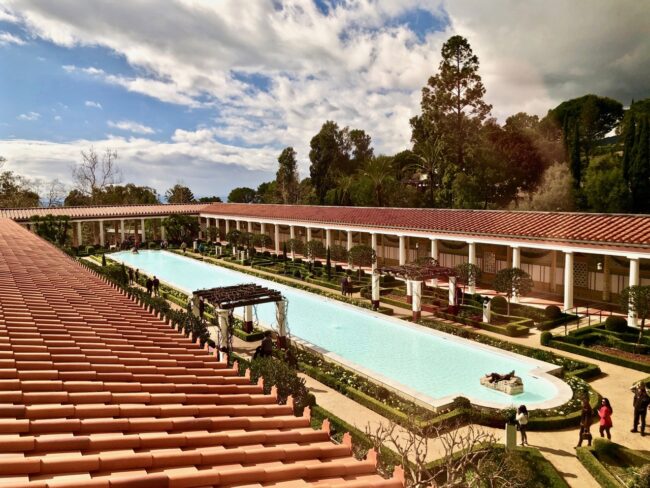


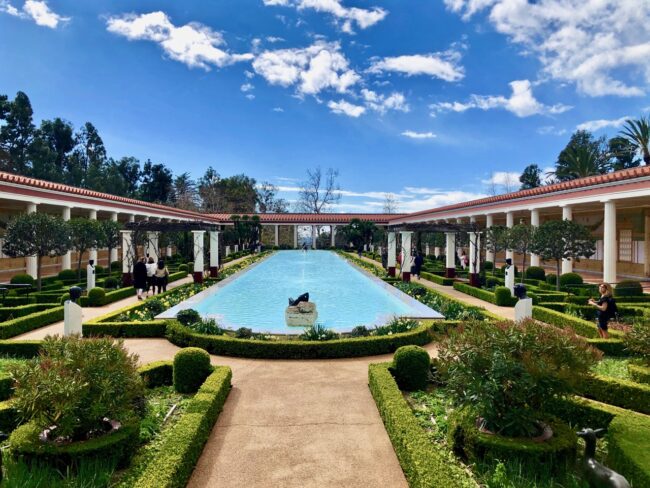



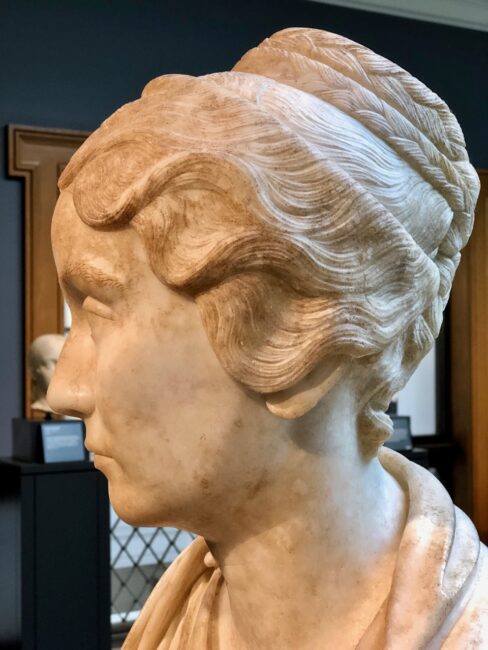










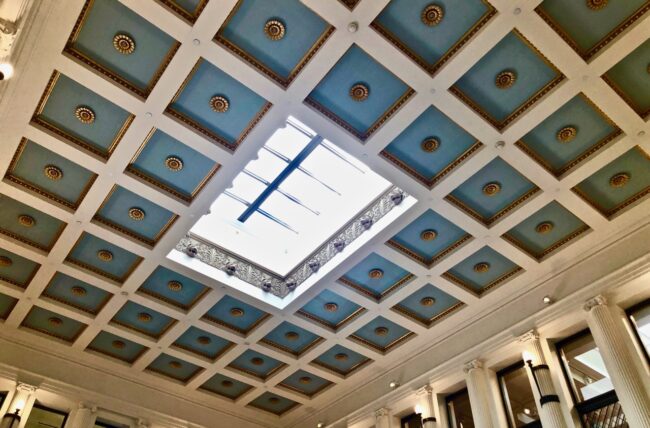





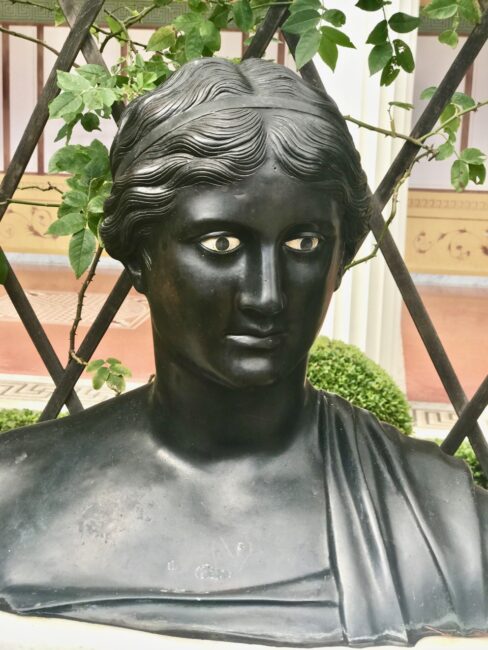



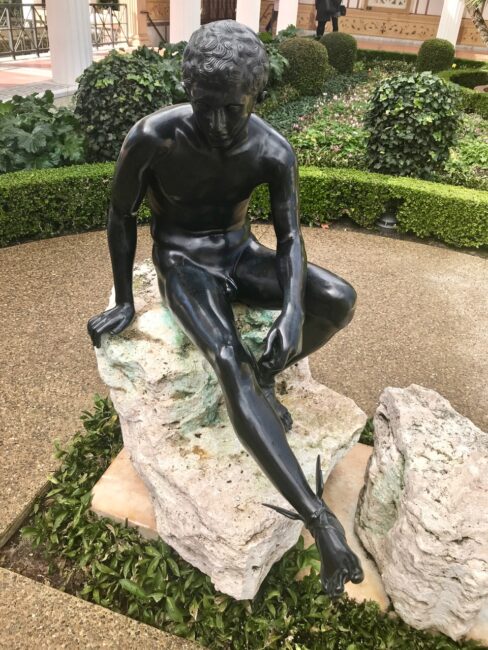





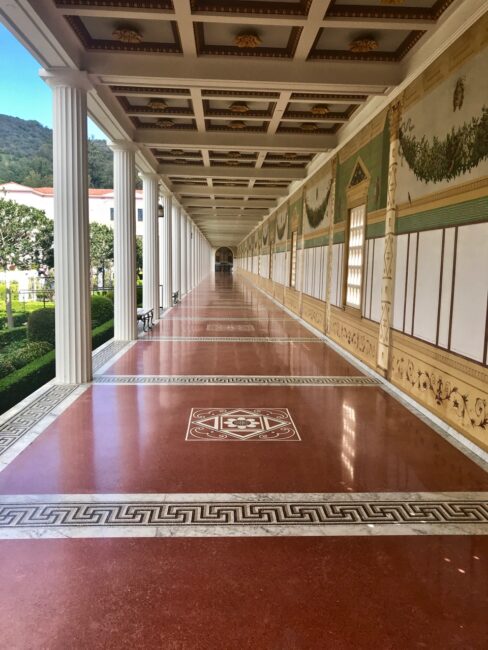








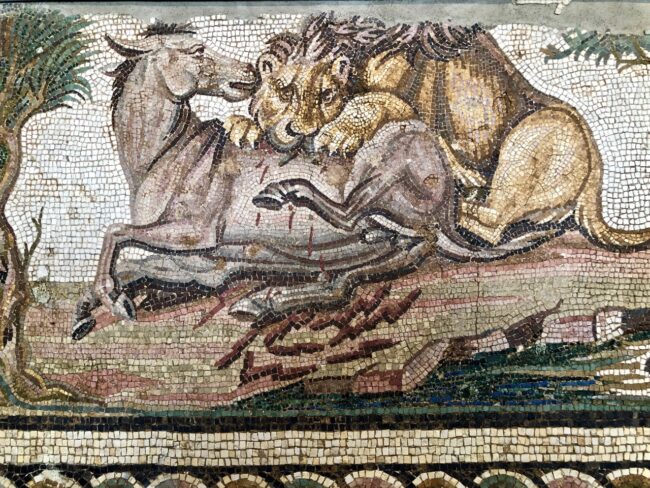





















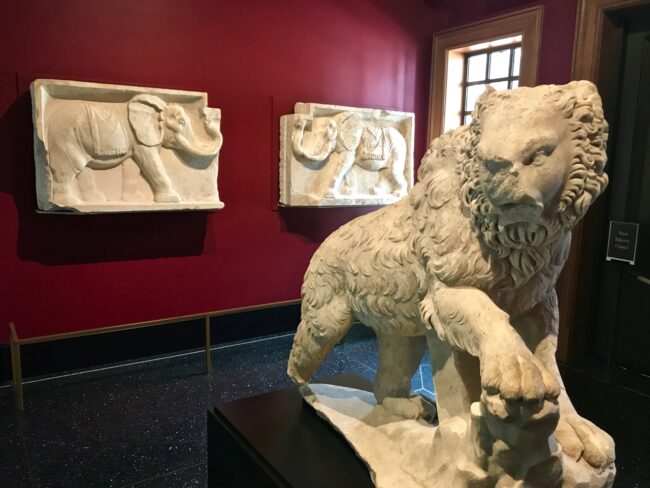










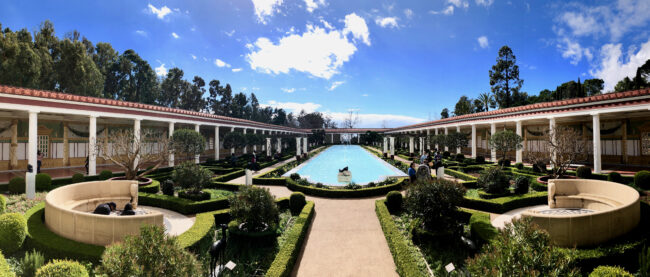





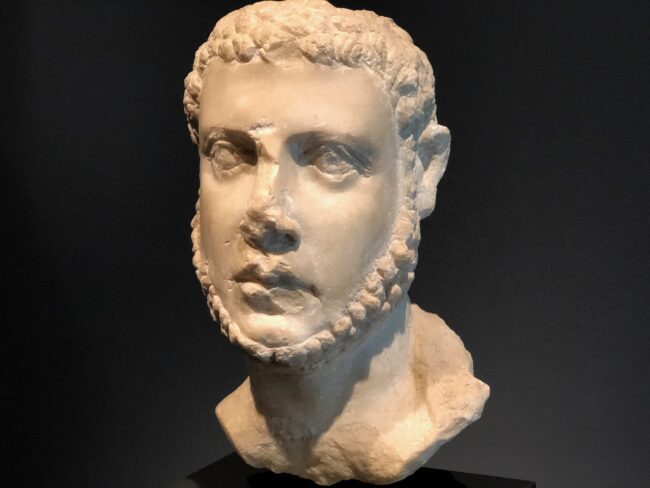


 .
. 
